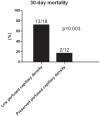Conventional hemodynamic resuscitation may fail to optimize tissue perfusion: an observational study on the effects of dobutamine, enoximone, and norepinephrine in patients with acute myocardial infarction complicated by cardiogenic shock
- PMID: 25084171
- PMCID: PMC4118994
- DOI: 10.1371/journal.pone.0103978
Conventional hemodynamic resuscitation may fail to optimize tissue perfusion: an observational study on the effects of dobutamine, enoximone, and norepinephrine in patients with acute myocardial infarction complicated by cardiogenic shock
Abstract
Aim: To investigate the effects of inotropic agents on parameters of tissue perfusion in patients with cardiogenic shock.
Methods and results: Thirty patients with cardiogenic shock were included. Patients received dobutamine, enoximone, or norepinephrine. We performed hemodynamic measurements at baseline and after titration of the inotropic agent until cardiac index (CI) ≥ 2.5 L.min-1.m(-2) or mixed-venous oxygen saturation (SvO2) ≥ 70% (dobutamine or enoximone), and mean arterial pressure (MAP) ≥ 70 mmHg (norepinephrine). As parameters of tissue perfusion, we measured central-peripheral temperature gradient (delta-T) and sublingual perfused capillary density (PCD). All patients reached predefined therapeutic targets. The inotropes did not significantly change delta-T. Dobutamine did not change PCD. Enoximone increased PCD (9.1 [8.9-10.2] vs. 11.4 [8.4-13.9] mm.mm(-2); p<0.05), and norepinephrine tended to decrease PCD (9.8 [8.5-11.9] vs. 8.8 [8.2-9.6] mm.mm-2, p = 0.08). Fifteen patients (50%) died within 30 days after admission. Patients who had low final PCD (≤ 10.3 mm.mm-2; 64%) were more likely to die than patients who had preserved PCD (>10.3 mm.mm(-2); mortality 72% vs. 17%, p = 0.003).
Conclusion: This study demonstrates the effects of commonly used inotropic agents on parameters of tissue perfusion in patients with cardiogenic shock. Despite hemodynamic optimization, tissue perfusion was not sufficiently restored in most patients. In these patients, mortality was high. Interventions directed at improving microcirculation may eventually help bridging the gap between improved hemodynamics and dismal patient outcome in cardiogenic shock.
Conflict of interest statement
Figures


References
-
- De Backer D, Creteur J, Dubois MJ, Sakr Y, Vincent JL (2004) Microvascular alterations in patients with acute severe heart failure and cardiogenic shock. Am Heart J 147: 91–99. - PubMed
-
- Joly HR, Weil MH (1969) Temperature of the great toe as an indication of the severity of shock. Circulation 39: 131–138. - PubMed
-
- Lima A, Jansen TC, van Bommel J, Ince C, Bakker J (2009) The prognostic value of the subjective assessment of peripheral perfusion in critically ill patients. Crit Care Med 37: 934–938. - PubMed
-
- den Uil CA, Lagrand WK, van der Ent M, Jewbali LS, Cheng JM, et al. (2010) Impaired microcirculation predicts poor outcome of patients with acute myocardial infarction complicated by cardiogenic shock. Eur Heart J 31: 3032–3039. - PubMed
Publication types
MeSH terms
Substances
LinkOut - more resources
Full Text Sources
Other Literature Sources
Medical
Research Materials
Miscellaneous

